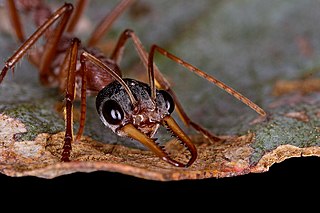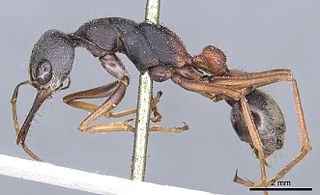
Myrmecia is a genus of ants first established by Danish zoologist Johan Christian Fabricius in 1804. The genus is a member of the subfamily Myrmeciinae of the family Formicidae. Myrmecia is a large genus of ants, comprising at least 93 species that are found throughout Australia and its coastal islands, while a single species is only known from New Caledonia. One species has been introduced out of its natural distribution and was found in New Zealand in 1940, but the ant was last seen in 1981. These ants are commonly known as bull ants, bulldog ants or jack jumper ants, and are also associated with many other common names. They are characterized by their extreme aggressiveness, ferocity, and painful stings. Some species are known for the jumping behavior they exhibit when agitated.

Myrmecia nigriceps, also known as the black-headed bull ant, is a species of ant endemic to Australia. A member of the genus Myrmecia in the subfamily Myrmeciinae, it was first described by Austrian entomologist Gustav Mayr in 1862. These ants are large, varying from 19 to 23 millimetres in length. However, colonies contain workers that are much smaller, usually half the size of normal workers. The queens are the largest while the males are the smallest, which can be easily identified due to their small mandibles.

Myrmecia desertorum is an Australian ant species belonging to the genus Myrmecia. They were first described by Wheeler in 1915, and are distributed all over Australia.

Myrmecia aberrans is an Australian bull ant of the genus Myrmecia. It is mostly spotted in South Australia and the states surroundings. The species of the bull ant was first described in 1900. The average length is around 12 millimetres. M. aberrans ants are commonly known as "wide jawed bull ants".

Myrmecia nigrocincta, commonly known as the jumper ant or jumping jack, is an ant of the genus Myrmecia. The species was first described by Frederick Smith in 1858. Colonies of this ant are abundant in eastern Australia. Ants of this species are known for their ability to jump up to 10 centimetres, and they also have a powerful, venomous sting. Rather than foraging on the ground, M. nigrocincta prefer to forage in trees where they are known to pollinate certain flowers.

Myrmecia fulvipes is a bull ant belonging the genus Myrmecia. Native to Australia, these bull ants are found in Tasmania, Victoria, New South Wales, and Queensland.

Myrmecia nobilis is a species of ant. It belongs to the genus Myrmecia, and was described by John S. Clark in 1943. Native to Australia, Myrmecia nobilis has only been observed in Victoria, particularly the Melbourne Metropolitan Area.
Myrmecia flammicollis is an Australian ant which belongs to the genus Myrmecia. It is native to Australia. They are usually distributed in the north of Queensland. They were described by William Brown in 1953.

Myrmecia pulchra is an Australian bull ant species, a part of the genus Myrmecia. They are native to Australia. They are heavily distributed in Victoria, Australian Capital Territory, and New South Wales, notably around the coastlines.

Myrmecia forceps is an Australian ant in the genus Myrmecia. This species is native to Australia and commonly distributed in most of the southern regions of Australia. They were described by Roger in 1861.

Myrmecia mjobergi is an Australian ant which belongs to the genus Myrmecia. This species is native to Australia. They are heavily distributed in Queensland, and are also distributed in the several other states. They were described by Auguste-Henri Forel in 1915.

Myrmecia nigriscapa is an Australian ant in the genus Myrmecia. This species is native to Australia and is heavily distributed along the southern coastlines of Australia with some presence in the inner areas of Australia.

Myrmecia luteiforceps is an Australian ant which belongs to the genus Myrmecia. This species is native to Australia. Their distribution in Australia has not been observed much but have been noted in New South Wales and Queensland. They were described by Wheeler in 1933.

Myrmecia froggatti is an Australian ant which belongs to the genus Myrmecia. This species is endemic to Australia. This species is distributed throughout all areas of New South Wales and elsewhere up north and south.

Myrmecia fuscipes is an Australian ant which belongs to the genus Myrmecia. This species is native to Australia. Their distribution is heavily observed in South Australia and Western Australia.
Myrmecia ferruginea is an Australian ant which belongs to the genus Myrmecia. This species is native to Australia. The Myrmecia ferrguinea has been notably distributed in Queensland.

Myrmecia tepperi is an Australian ant which belongs to the genus Myrmecia. This species is native to Australia. Their distribution is large in Western Australia, South Australia, and New South Wales.
Myrmecia maura is an Australian ant which belongs to the genus Myrmecia. This species is native to Australia. Their distribution in Australia is mostly around the Australian Capital Territory and New South Wales.
Myrmecia formosa is an Australian ant which belongs to the genus Myrmecia. This species is native to Australia. Their distribution in Australia has notably been studied and collected in New South Wales.

Myrmecia varians is an Australian ant which belongs to the genus Myrmecia. This species is endemic to Australia. The Myrmecia varians is one of the most distributed ants in the country, with the species being observed in every single state and territory except for Tasmania. Myrmecia varians was first described by Mayr in 1876.
















